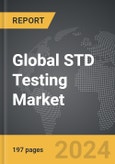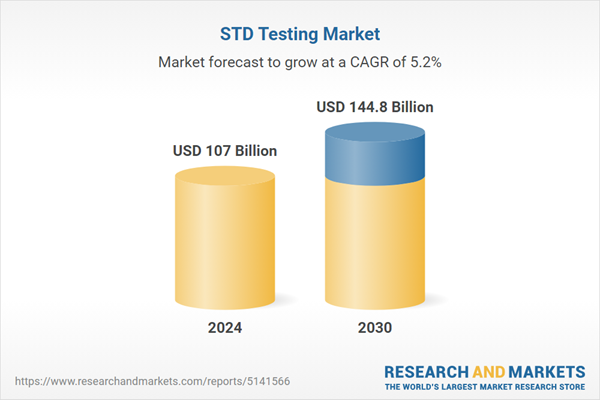Global STD Testing Market - Key Trends & Drivers Summarized
Why Is STD Testing Gaining Urgency and Attention Worldwide?
The rising prevalence of sexually transmitted diseases (STDs) across the globe has led to a significant increase in demand for STD testing services. Factors such as changing sexual behavior, lack of awareness, and inadequate education on safe practices have contributed to the surge in STD cases. In response, healthcare organizations and governments are promoting early diagnosis and routine testing to curb the spread of infections and improve patient outcomes. The expansion of public health campaigns and increased access to healthcare services, particularly in developing regions, are also contributing to the emphasis on STD testing. With diseases like HIV, chlamydia, gonorrhea, and syphilis being major public health concerns, the importance of accessible, reliable, and rapid testing solutions continues to grow, underscoring the urgent need for comprehensive testing programs worldwide.How Are Technological Advancements Influencing the STD Testing Landscape?
The STD testing market is being reshaped by technological advancements aimed at improving diagnostic speed, accuracy, and accessibility. Point-of-care (POC) testing devices are becoming increasingly popular, offering rapid results without the need for laboratory processing, which is essential for early intervention and treatment. Molecular diagnostics, such as polymerase chain reaction (PCR) tests, are enhancing the precision of STD detection, allowing for the identification of multiple pathogens from a single sample. Self-testing kits, which can be used privately at home, are also gaining traction as they provide a convenient and discreet way for individuals to manage their sexual health. The integration of mobile health (mHealth) platforms that connect users with healthcare professionals for remote consultations and result interpretation is further enhancing the reach and efficiency of STD testing services, especially in remote or underserved areas.What Are the Market Trends Influencing the Demand for STD Testing Services?
The increasing awareness of sexual health and the rising prevalence of STDs, particularly among the younger population, are significantly influencing the demand for STD testing services. Educational campaigns and public health initiatives, particularly those targeting at-risk groups like young adults, LGBTQ+ communities, and sex workers, are emphasizing the importance of regular testing and early diagnosis. The shift towards preventive healthcare and personalized medicine is also playing a role, as healthcare providers advocate for proactive screening and routine check-ups to mitigate the spread of infections. Additionally, the expansion of telemedicine services, which offer convenient access to STD testing and consultations, is making testing more accessible and appealing, particularly in the wake of the COVID-19 pandemic, which accelerated the adoption of remote healthcare solutions. These trends indicate a growing acceptance and demand for routine STD testing as part of comprehensive healthcare management.What Factors Are Driving the Growth of the STD Testing Market?
The growth in the STD testing market is driven by several factors, including the rising prevalence of STDs, technological advancements in diagnostic tools, and the increasing emphasis on preventive healthcare. The expansion of point-of-care testing technologies and the availability of at-home testing kits are making testing more accessible, particularly for individuals who prefer privacy and convenience. The integration of molecular diagnostics, which enhances the accuracy and speed of test results, is attracting healthcare providers looking for efficient ways to manage and prevent the spread of infections. Public health initiatives and educational campaigns are also expanding testing access, particularly in developing regions where healthcare infrastructure is improving. Additionally, the widespread adoption of telemedicine services is facilitating remote consultations and access to testing, further supporting market growth. These combined factors are propelling the expansion of the STD testing market, making it a critical component of modern healthcare.Report Scope
The report analyzes the STD Testing market, presented in terms of market value (US$ Thousand). The analysis covers the key segments and geographic regions outlined below.- Segments: Disease Type (Chlamydia, Herpes Simplex Virus, Gonorrhea, Human Papillomavirus (HPV), Syphilis, Other Disease Types); Location (Laboratory, Point-of-Care (POC)).
- Geographic Regions/Countries:World; United States; Canada; Japan; China; Europe (France; Germany; Italy; United Kingdom; Spain; Russia; and Rest of Europe); Asia-Pacific (Australia; India; South Korea; and Rest of Asia-Pacific); Latin America (Argentina; Brazil; Mexico; and Rest of Latin America); Middle East (Iran; Israel; Saudi Arabia; United Arab Emirates; and Rest of Middle East); and Africa.
Key Insights:
- Market Growth: Understand the significant growth trajectory of the Chlamydia Testing segment, which is expected to reach US$40.6 Billion by 2030 with a CAGR of a 5%. The Herpes Simplex Virus Testing segment is also set to grow at 6% CAGR over the analysis period.
- Regional Analysis: Gain insights into the U.S. market, valued at $28.4 Billion in 2024, and China, forecasted to grow at an impressive 8.2% CAGR to reach $31.5 Billion by 2030. Discover growth trends in other key regions, including Japan, Canada, Germany, and the Asia-Pacific.
Why You Should Buy This Report:
- Detailed Market Analysis: Access a thorough analysis of the Global STD Testing Market, covering all major geographic regions and market segments.
- Competitive Insights: Get an overview of the competitive landscape, including the market presence of major players across different geographies.
- Future Trends and Drivers: Understand the key trends and drivers shaping the future of the Global STD Testing Market.
- Actionable Insights: Benefit from actionable insights that can help you identify new revenue opportunities and make strategic business decisions.
Key Questions Answered:
- How is the Global STD Testing Market expected to evolve by 2030?
- What are the main drivers and restraints affecting the market?
- Which market segments will grow the most over the forecast period?
- How will market shares for different regions and segments change by 2030?
- Who are the leading players in the market, and what are their prospects?
Report Features:
- Comprehensive Market Data: Independent analysis of annual sales and market forecasts in US$ Million from 2024 to 2030.
- In-Depth Regional Analysis: Detailed insights into key markets, including the U.S., China, Japan, Canada, Europe, Asia-Pacific, Latin America, Middle East, and Africa.
- Company Profiles: Coverage of players such as Alere, Inc., Becton, Dickinson and Company, bioMerieux SA, Danaher Corporation, F. Hoffmann-La Roche AG and more.
- Complimentary Updates: Receive free report updates for one year to keep you informed of the latest market developments.
Some of the 47 companies featured in this STD Testing market report include:
- Alere, Inc.
- Becton, Dickinson and Company
- bioMerieux SA
- Danaher Corporation
- F. Hoffmann-La Roche AG
- Hologic, Inc.
This edition integrates the latest global trade and economic shifts into comprehensive market analysis. Key updates include:
- Tariff and Trade Impact: Insights into global tariff negotiations across 180+ countries, with analysis of supply chain turbulence, sourcing disruptions, and geographic realignment. Special focus on 2025 as a pivotal year for trade tensions, including updated perspectives on the Trump-era tariffs.
- Adjusted Forecasts and Analytics: Revised global and regional market forecasts through 2030, incorporating tariff effects, economic uncertainty, and structural changes in globalization. Includes historical analysis from 2015 to 2023.
- Strategic Market Dynamics: Evaluation of revised market prospects, regional outlooks, and key economic indicators such as population and urbanization trends.
- Innovation & Technology Trends: Latest developments in product and process innovation, emerging technologies, and key industry drivers shaping the competitive landscape.
- Competitive Intelligence: Updated global market share estimates for 2025, competitive positioning of major players (Strong/Active/Niche/Trivial), and refined focus on leading global brands and core players.
- Expert Insight & Commentary: Strategic analysis from economists, trade experts, and domain specialists to contextualize market shifts and identify emerging opportunities.
Table of Contents
Companies Mentioned (Partial List)
A selection of companies mentioned in this report includes, but is not limited to:
- Alere, Inc.
- Becton, Dickinson and Company
- bioMerieux SA
- Danaher Corporation
- F. Hoffmann-La Roche AG
- Hologic, Inc.
Table Information
| Report Attribute | Details |
|---|---|
| No. of Pages | 197 |
| Published | December 2025 |
| Forecast Period | 2024 - 2030 |
| Estimated Market Value ( USD | $ 107 Billion |
| Forecasted Market Value ( USD | $ 144.8 Billion |
| Compound Annual Growth Rate | 5.2% |
| Regions Covered | Global |









